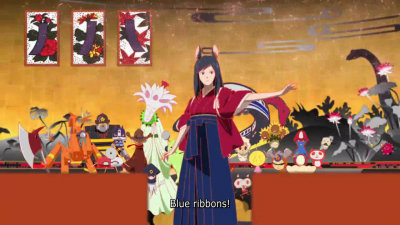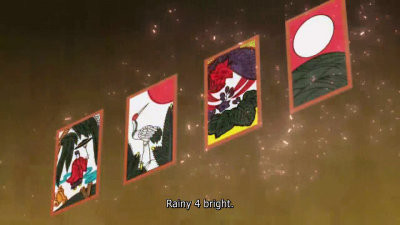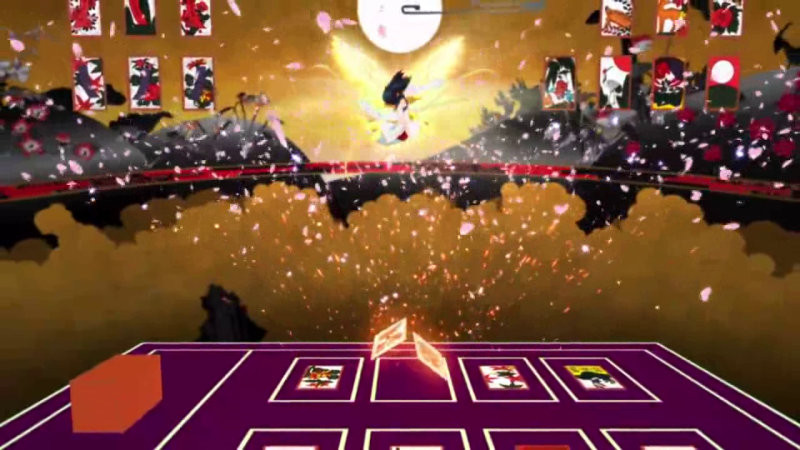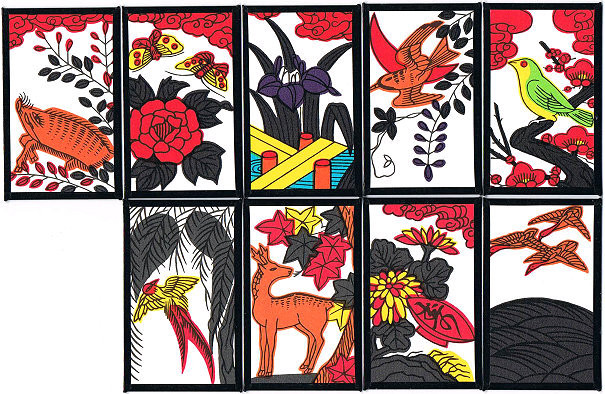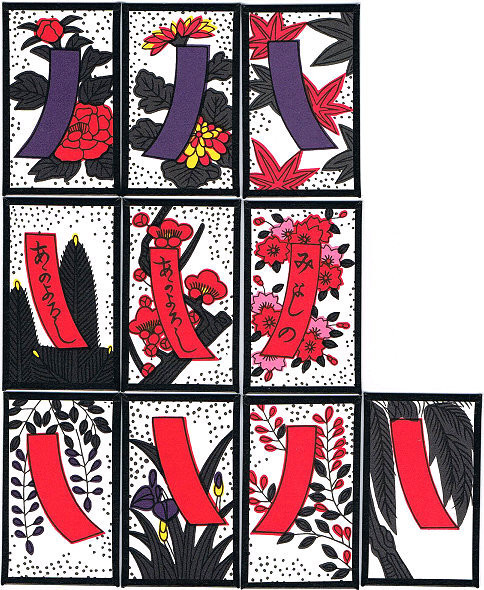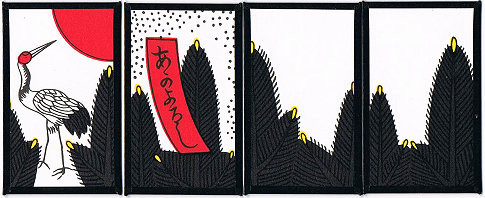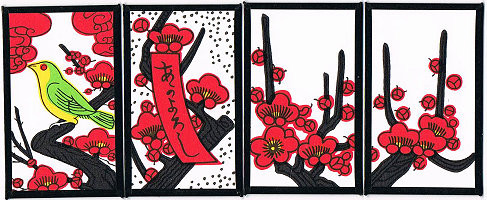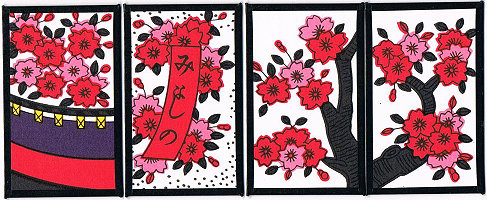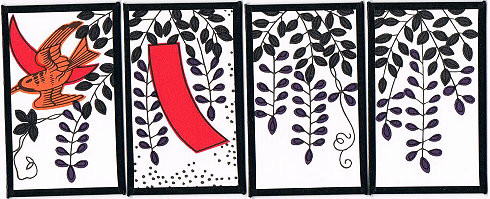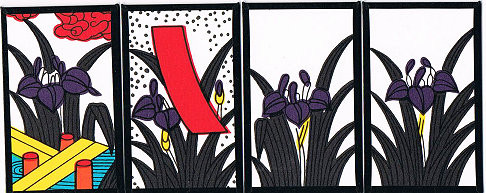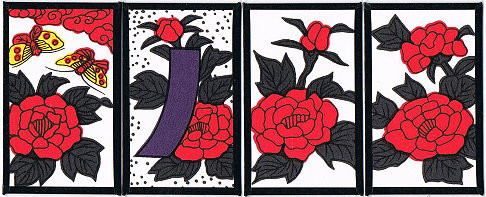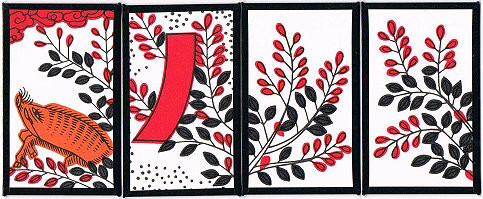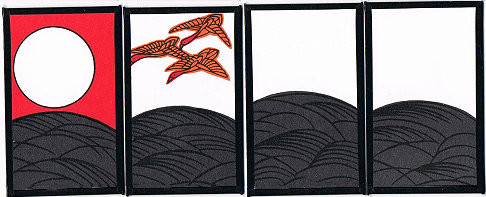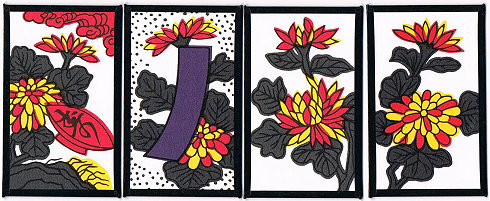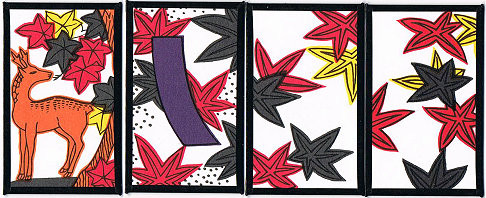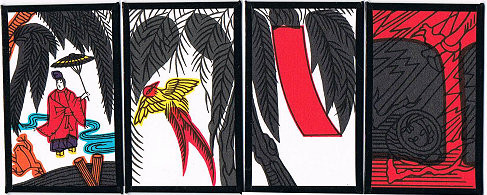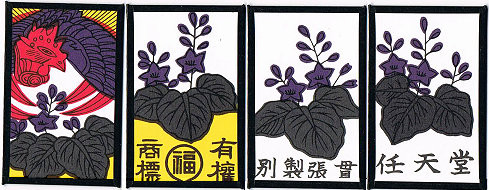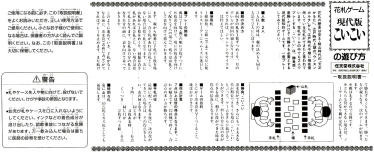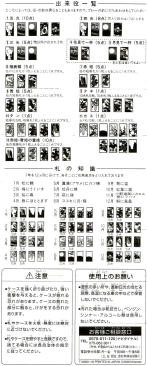Rick's b.log - entry 2011/07/29 |
| ||||||
mailto: blog -at- heyrick -dot- eu
You are not reading my b.log using HTTPS. You can switch to HTTPS by clicking here.
Hanafuda Koi-koiHanafuda is a Japanese deck of playing cards, and Koi-koi is a popular, and fairly simple, game played with these cards.The cards themselves are a lot smaller than a Western playing card, about a third of the size, and they are a fair bit thicker. They don't bend, but they do provide a very satisfying 'snap' sound when you're engaged in a game. Shuffling them can be... tricky.
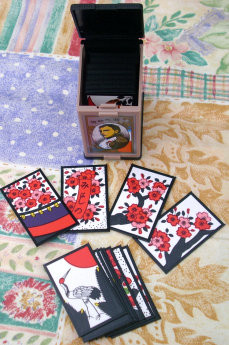
A little bit of history: you might be surprised if you obtain a deck and find it in a cute little Nintendo box, as pictured above.
How I found out about thisIt's a fairly important plot point in the animated film "Summer Wars". It seemed an interesting game, which didn't look too difficult to master, yet offered endless strategy options.
If you decide to watch this film, and I recommend it, don't be put off by the complicated-looking "virtual world" shown in the beginning. The virtual world occupies about a fifth of the movie. It is a rather sweet and engaging film, somewhat in the Ghibli tradition.
The Hanafuda cardsPerhaps the most complicated thing about Hanafuda are the cards.Traditional Western playing cards have four suits in two colours (hearts and diamonds for red, spades and clubs for black), and they are numbered with Ace being 1 (or a high card, depending on the game) plus Jacks/Knaves, Queens, and Kings. There are also, for some games, two Joker cards. By contrast, Hanafuda consists of twelve suits of four cards. Each suit carries a botanical theme (willow, cherry blossom, chrysanthemum...) which also relates to a month of the year. Indeed, Hanafuda translates as "flower cards". As with Western playing cards, each card nominally carries a value. I say nominally, for the value of the card is not used in Koi-koi, for you gain points by the combinations made. These combinations are called "yaku". Within these suits, there are five different sorts of card:
Now we shall look at the cards suit by suit.
Playing Koi-KoiKoi-koi is a game for two players.The "dealer" is selected by whatever method suits the players. The dealer shuffles, the other cuts, and so on. The cards are then dealt in a specific manner:
Before play, the cards dealt face up should be examined, as follows:
There are two instant win conditions for a dealt hand. These are:
Some assume that the dealer will play first. I prefer the variation where both players take a card from the top of the stack (dealer first). Whoever has a card from the earliest month in the year will be the first to play. [those two cards are then reinserted into the stack]
Playing Each player plays in turn. A turn consists of the following two actions:
Firstly, a player takes a card from their hand and places it, face up, into the centre area of the table. Next, you take the next card off of the stack, and look to see if it matches a card in the centre. If it does, place it on top to capture the card, otherwise place it alongside. Finally, if you have captured any cards, you should now take these and place them into your playing area face up (the right hand side, by tradition), and organised according to their classment (brights, animals, ribbons, plains). The strict rules state that a match must be made if it is possible. However I prefer to play with the more stretegic approach that a match must be made only with the card drawn from the stack. If you choose not to make a match from the cards in your hand, for whatever reason, then you don't need to. As you might have guessed, this game mixes luck with skill. Don't just haphazardly match cards, you're looking to get the cards that will gain you a yaku.
Errors
It may be that a player commits an error - either in placing a card and not recognising a match, or forgetting to take a card from the pile. My personal take on this is that if a match was not noticed, the player can correct this while it is still that player's move. In other words, if they've just taken and placed the card from the stack and they think "hang on!", they can do something about it. If you decide to be more lenient in your game, keep in mind that if allowing a player to correct a move later on could dramatically alter the game - will you be willing to undo your moves to give them their rightful card? Or will you be happy if the card you were waiting for to complete your bonus yaku ends up in their hands when it would have otherwise been yours? To say a missed opportunity is forfeit seems to me to be the best solution.
Koi-koi! At the point when any player makes a "Yaku", a winning combination, the game pauses.
The player must then decide to say "Stop" to stop and win the game with however many points they have, or "Koi-koi" to continue playing to aim for more yaku and more points. Ready?
Okay. With every Koi-koi, the scoring increases. One koi-koi and scores double. Two Koi-koi and scores triple, and so on. Some variations of the game take it a stage further in that if a player calls "Koi-koi" and then loses, the amount won by the winning player is deducted from the losing player's score. You might want to leave that one until you're an expert player... In a nutshell: Koi-koi offers you two options - to come up with love bubbles around your head and animated kittens frolicking at your feet... or to crash and burn horribly. Your strategy, and a big dose of luck, decides how the game will turn out.
Yaku / scores I've noticed that sites seem to be all over the place regarding scoring, so here are the official scores from the little instruction sheet included in my Nintendo Hanafuda, which we can probably consider to be a more authorative source...
There are two ways of scoring:
Scoring ONLY takes place when a player says "stop". The yaku are counted, in all possible permutations, and added up. If any multiplier is in play, this is used to arrive at the final score. The person who said "stop" takes the game, the other player wins nothing.
Basic strategies You can use the Plain cards to match - matching goes by suit alone. So if you have a plain pampas and the full moon in on the table (or vice versa in your hand), go for it. Cards matched and placed on the right are "safe". To a degree, valuable cards in your hand are also safe. There may be no match at the moment, but a suitable card may come up. But don't leave it too long, you can't yaku from unplayed cards. Aim to take the Saké Cup - it is important! A risky strategy for playing an important card if you have a match in your hand but there is no match on the table is to place the lower value card on the table as a 'discard'. When it is your next turn, you place the other card and match it to the one you placed earlier. This is risky as the other person may match the initial card, or the cards drawn from the stack may match, leaving you with a potentially unplayable card. Don't dispair if you were looking for poetry ribbons and your opponent nabs the final one. You can still form other yaku (five ribbons, for example). Pay attention not only to yourself, but to the cards the opponent plays.
Don't aim for the Brights. They're good points, but there are alternatives. And finally, nobody in their right mind would declare Stop on a single-point yaku except to block their opponent winning with a bigger yaku score. Otherwise, just say koi-koi for if you lose, you pass up a single point. But you could win a fair bit more. It's worth it.
Practice, practice, practice! There's only one way it'll make sense to you. That's if you play. Often. Find a willing opponent and go for it whenever it is convenient. [actually, truth be told, finding a Hanafuda deck might be more difficult than finding an opponent!]
The official rulesHere are scans of the official rules leaflet. In Japanese!Click the small picture for a larger version: Hint - the Kanji that looks like an iron with steam coming out of it ('点') means "points", which may be enough that you can do a very basic interpretation of the score sheet (the tall one).
Game walkthroughHere is a walk-through of an example game. The cards are laid out on the table so make things clearer, however note that you do not show your hand (for this reason, my opponent's hand will be obscured).
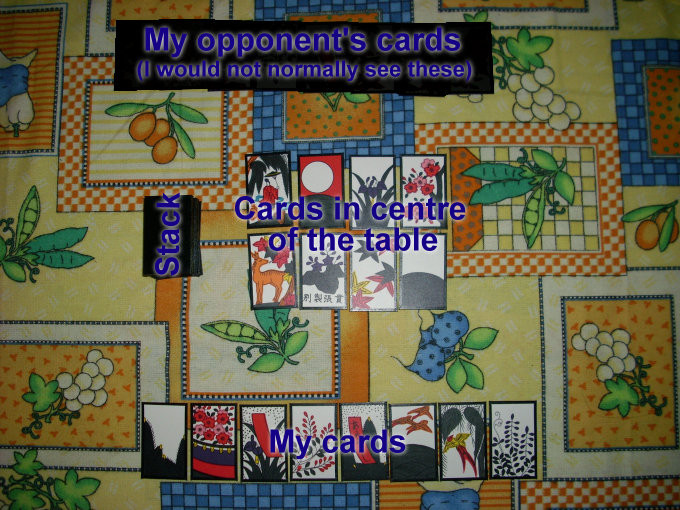 Looking at the cards, in the centre of the table is one animal - the Deer, and two brights - Rain Man and Full Moon. Meanwhile, in my hand are two animal cards - Geese and Swallow, one Bright - the Sakura Curtain, and two red Ribbons, one being a poetry ribbon. Having won the selection, I go first. I take my Willow Swallow and match it to capture the Rain Man. 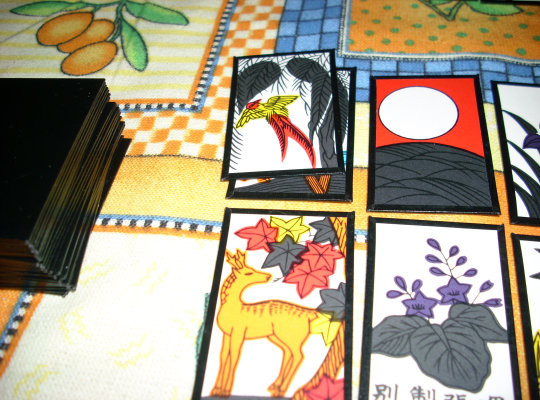 I turn the top card on the stack. It is Pampas Grass. I can match this with the Full Moon Bright to capture it. 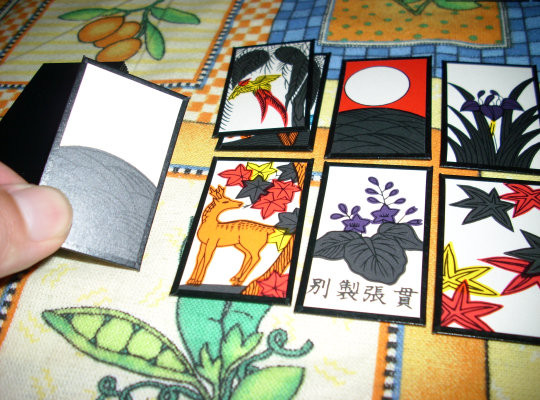 The captured cards are now 'safe', so I have moved them to the lower right of my part of the play area. As you can see, I have arranged them by type - one Plain, a Animal, and two Brights. 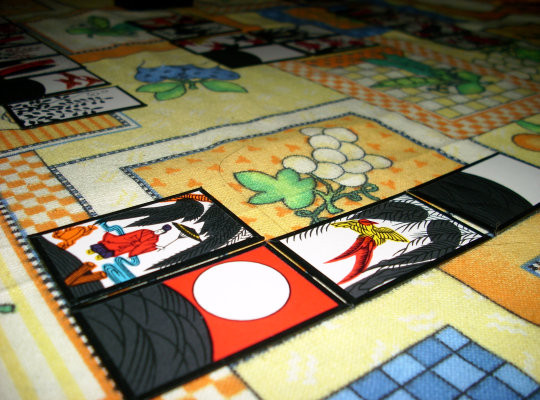
This ends my turn. 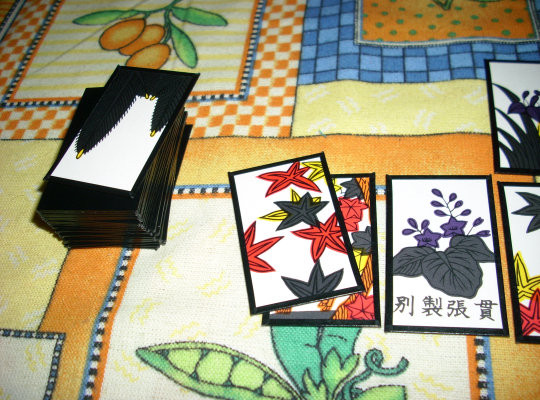 Back to my turn, I use my Sakura Curtain (a Bright) to match the Cherry blossom Plain on the table, and I turn over an Animal - the Dock - from the stack. The Dock is an Iris card, which matches the Iris card in the centre of the table. 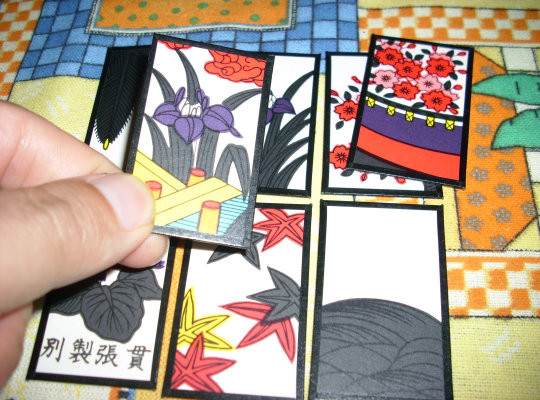 At this point, my safe area will now contain two Animals (Deer and Swallow), three Brights (Full Moon, Curtain, and Rain Man), and some Plains. While I have three Brights, one of them is the Rain Man, so there is no Yaku yet. For my opponent's turn, a Maple Blue Ribbon matches with a Maple Plain. The next card on the stack is an Iris Plain, which matches nothing, so it remains in the centre of the table. 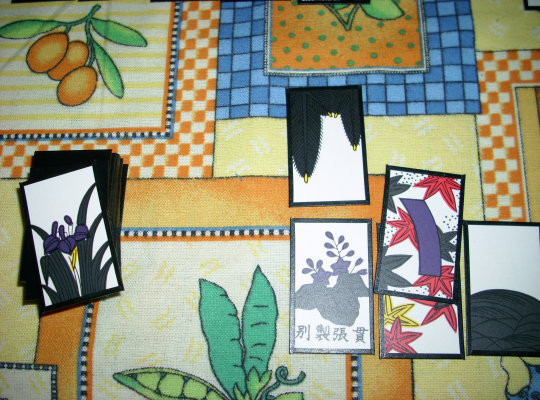 For my turn, the Iris just placed by my opponent conveniently matches my Iris Red Ribbon, so I play that card. Then I take a card from the stack, which is the Phoenix Bright, matching the Paulownia in the centre of the table. 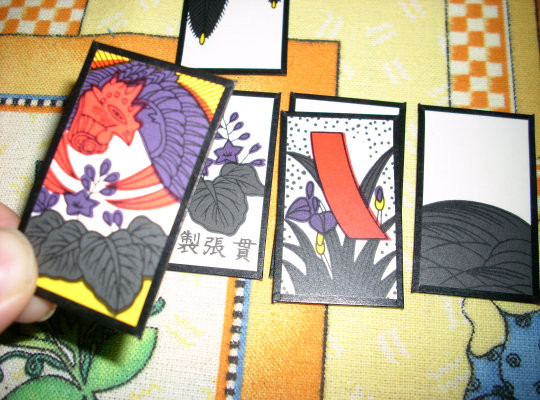 My turn is not over yet! If you look at my 'safe' cards, you'll see that I have three Brights and the Rain Man, highlighted in the ever-so-slightly enhanced photo below. This is a Rainy Four Bright, a yaku worth seven points. 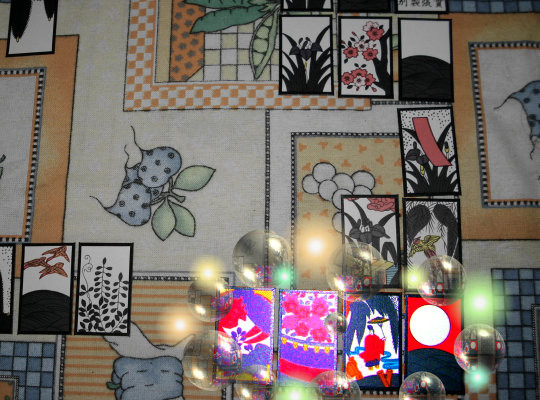 I can look over and see my poor opponent has one Animal and One Ribbon. I have a good number of cards to play, and I have plenty of 'safe' cards, although there is nothing 'in the waiting'. I will, however, look to see if I can gain a few more points, so I shall call... Koi-koi!
But I am very aware that if my opponent should form a yaku, even a single point yaku, then the choice of Stop or Koi-koi is theirs to make. If the game is stopped, they gain a single point, and I lose everything. But fingers crossed! Here is the game area at this time: 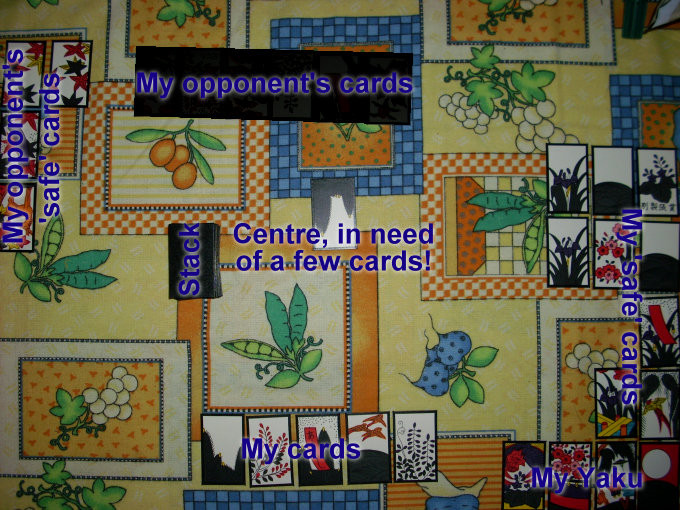 And the game continues in the manner shown.
My opponent, however, thinks that I might have fixed things in order to get a good Yaku without two dozen photos. I deny any such ridiculous allegation, but my opponent isn't buying my excuses... 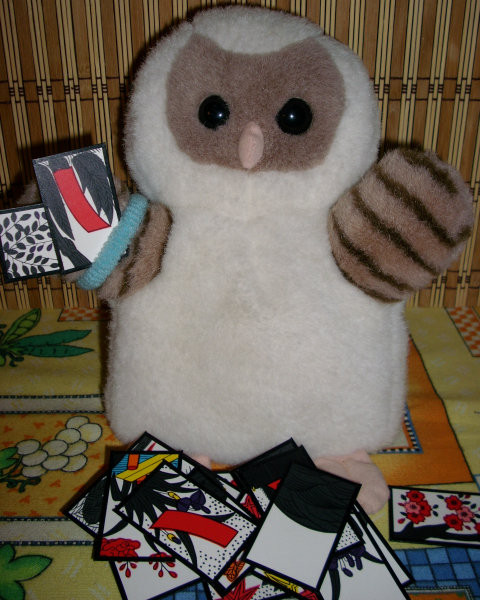
And...And there you have it. I think this is my most in-depth b.log entry ever, plus one of the longest to write (two and a half days) plus the research involved (four days) plus learning it myself and teaching mom so I have somebody to play.What annoys me the most, I think, is that mom totally kicks my ass. She was pleasantly surprised with her first win (as shown in the photo), but this trend continued such that I'm thinking of blowing a month's pay to drag mom to Japan where she can gamble her way to a fortune... But maybe mom cheats? Check out the evidence in the photo on the right. Two brains are better than one, right? Even if one is furry, uninterested in the game, and thinking little more than "feed me!"... 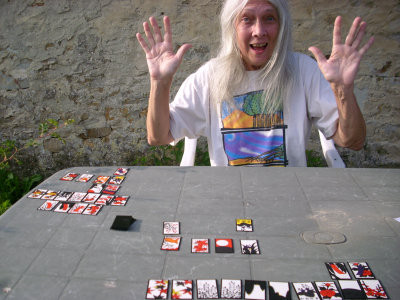 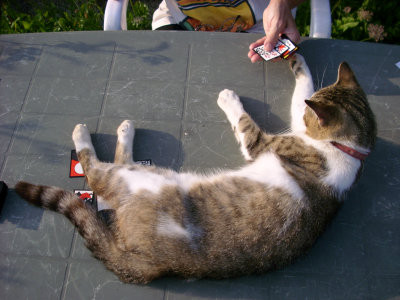 All said and done, if I can encourage just one or two of my readers to seek out this interesting game, it'll have been worthwhile. ☺
Your comments:Please note that while I check this page every so often, I am not able to control what users write; therefore I disclaim all liability for unpleasant and/or infringing and/or defamatory material. Undesired content will be removed as soon as it is noticed. By leaving a comment, you agree not to post material that is illegal or in bad taste, and you should be aware that the time and your IP address are both recorded, should it be necessary to find out who you are. Oh, and don't bother trying to inline HTML. I'm not that stupid! ☺ ADDING COMMENTS DOES NOT WORK IF READING TRANSLATED VERSIONS.
|
(Felicity? Marte? Find out!)
📺 The SIBA stories 📹
It's a simple substring match.
Last read at 06:18 on 2024/04/20.


| |||||||||||||||||||||||||||||||||||||||||||||||||||||||||||||||||||||||||||||||||||||||||||||||||||||||||||||||
| Next entry - 2011/08/03 Return to top of page | ||||||||||||||||||||||||||||||||||||||||||||||||||||||||||||||||||||||||||||||||||||||||||||||||||||||||||||||||
| © 2011 Rick Murray |
| Retrieved from http://www.heyrick.co.uk/blog/index.php?diary=20110729 on 20th April 2024 |
